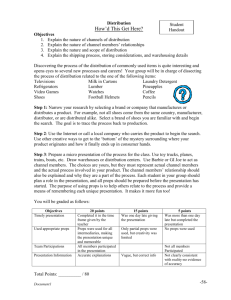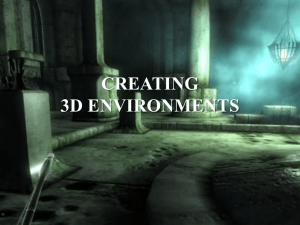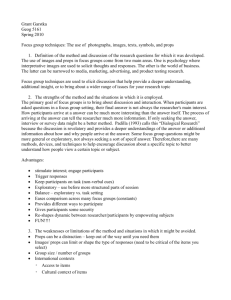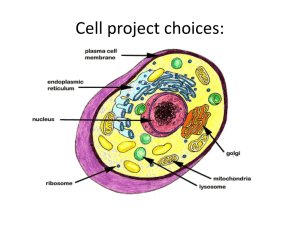CUEPRP03B - Board of Studies NSW
advertisement
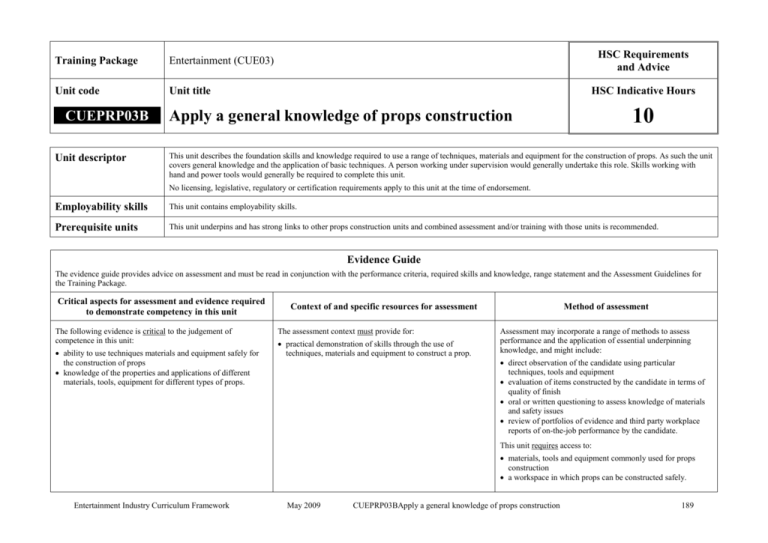
Training Package Entertainment (CUE03) Unit code Unit title CUEPRP03B Unit descriptor HSC Requirements and Advice HSC Indicative Hours 10 Apply a general knowledge of props construction This unit describes the foundation skills and knowledge required to use a range of techniques, materials and equipment for the construction of props. As such the unit covers general knowledge and the application of basic techniques. A person working under supervision would generally undertake this role. Skills working with hand and power tools would generally be required to complete this unit. No licensing, legislative, regulatory or certification requirements apply to this unit at the time of endorsement. Employability skills This unit contains employability skills. Prerequisite units This unit underpins and has strong links to other props construction units and combined assessment and/or training with those units is recommended. Evidence Guide The evidence guide provides advice on assessment and must be read in conjunction with the performance criteria, required skills and knowledge, range statement and the Assessment Guidelines for the Training Package. Critical aspects for assessment and evidence required to demonstrate competency in this unit The following evidence is critical to the judgement of competence in this unit: ability to use techniques materials and equipment safely for the construction of props knowledge of the properties and applications of different materials, tools, equipment for different types of props. Context of and specific resources for assessment The assessment context must provide for: practical demonstration of skills through the use of techniques, materials and equipment to construct a prop. Method of assessment Assessment may incorporate a range of methods to assess performance and the application of essential underpinning knowledge, and might include: direct observation of the candidate using particular techniques, tools and equipment evaluation of items constructed by the candidate in terms of quality of finish oral or written questioning to assess knowledge of materials and safety issues review of portfolios of evidence and third party workplace reports of on-the-job performance by the candidate. This unit requires access to: materials, tools and equipment commonly used for props construction a workspace in which props can be constructed safely. Entertainment Industry Curriculum Framework May 2009 CUEPRP03BApply a general knowledge of props construction 189 Required Skills and Knowledge This section describes the skills and knowledge required for this unit. Required skills Required knowledge literacy skills sufficient to interpret props documentation and read product labels numeracy skills sufficient to calculate quantities of materials and take basic measurements. the scope of props items that may be constructed and the factors that impact on whether to construct or acquire by other means the properties and applications of materials commonly used for prop construction, including paper, latex, foam, canvas and leather the properties and applications of contact adhesives commonly used for props construction types of tools commonly used for props construction safety and environmental issues associated with the use of tools, materials and adhesives techniques for the manipulation of materials commonly used in prop construction the links between the intended use of a prop and the selection of materials and construction method. Entertainment Industry Curriculum Framework May 2009 CUEPRP03BApply a general knowledge of props construction 190 Element Performance Criteria Range Statement 1 1.1 The range statement relates to the unit of competency as a whole. It allows for different work environments and situations that may affect performance. Bold italicised wording, if used in the performance criteria, is detailed below. Select equipment and materials in preparation for construction. Liaise with supervisor to determine the nature of props to be constructed. Essential operating conditions that may be present with training and assessment (depending on the work situation, needs of the candidate, accessibility of the item, and local industry and regional contexts) may also be included. Props requiring construction may include a vast range of items but props construction at this level would generally involve the use of: adhesives (e.g. PVA glue, liquid nails) canvas foam latex leather paper. 2 Use props construction techniques. 1.2 Correctly identify and select appropriate materials for prop construction in accordance with instructions and the intended use for the prop. 1.3 Calculate correct quantities of materials required and minimise waste where possible. 1.4 Select appropriate equipment and tools in accordance with materials being used and type of prop construction required. 2.1 Correctly use techniques to construct props, including the safe use of adhesives. 2.2 Complete the prop construction process in a logical manner. 2.3 Follow appropriate safety procedures throughout the prop construction process in accordance with organisational and legislative requirements. Entertainment Industry Curriculum Framework May 2009 Tools and equipment for prop construction may include: hand tools power tools scissors/cutters sewing machines. Safety procedures associated with the use of props construction materials may include: adherence to product instruction ensuring adequate ventilation warning colleagues about use of specific chemicals wearing of protective clothing. CUEPRP03BApply a general knowledge of props construction 191 Element Performance Criteria Range Statement 2.4 Work co-operatively with other team members to ensure efficiency and quality in the set construction process. 2.5 Identify any problems with the prop construction process promptly and take appropriate action within scope of individual responsibility. Entertainment Industry Curriculum Framework May 2009 Typical problems that may occur in props construction may include: difficulty in achieving sufficient adhesion need to change combinations of materials. CUEPRP03BApply a general knowledge of props construction 192


